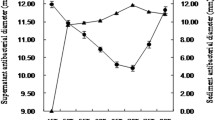Abstract
Screening the collection of natural isolates from semi-hard homemade cheese resulted in isolation and characterization of strain Lactobacillus paracasei subsp. paracasei BGSJ2-8. The strain BGSJ2-8 harbors several important phenotypes, such as bacteriocin production, aggregation phenomenon, and production of proteinase. Bacteriocin SJ was purified by three-step chromatography. Mass spectrometry established molecular mass of the active peptide at 5372 Da. The auto-aggregation phenotype of wild-type (WT) strain was mediated by secreted aggregation-promoting factor (protein of molecular mass > 200 kDa), probably acting in cooperation with other cell surface protein(s). Comparative study of WT and its spontaneous nonaggregating derivative revealed that aggregation factor was responsible for the observed differences in the bacteriocin and proteinase activities. Bacteriocin SJ activity and resistance to different stresses were higher in the presence of aggregating factor. In contrast, proteinase activity was stronger in the nonaggregating derivative.




Similar content being viewed by others
References
Boonaert CJP, Rouxhet PG (2000) Surface of lactic acid bacteria: Relationships between chemical composition and physico-chemical properties. Appl Environ Microbiol 66:2548–2554
Boris S, Suarez JE, Barbes C (1997) Characterization of the aggregation promoting factor from Lactobacillus gasseri, a vaginal isolate. J Appl Microbiol 83:413–420
Cotter DP, Hill C, Ross P (2005) Bacteriocins: Developing innate immunity for food. Nat Rev 3:777–788
Fox PF, Wallace JM, Morgan S, Lynch CM, Niland EJ, Tobin J (1996) Acceleration of cheese ripening. In: Venema G, Huis In’T Veld JHJ, Hugenholtz J (eds) Lactic acid bacteria: Genetics, metabolism and applications. Antonie van Leeuwenhoek, vol. 70. The Netherlands: Kluwer Academic, pp 271–297
Fuller R (1992) Probiotics: The scientific basis. London, UK: Chapman & Hall
Huber B, Riedel K, Köthe M, Givskov M, Molin S, Eberl L (2002) Genetic analysis of functions involved in the late stages of biofilm development in Burkholderia cepacia H111. Mol Microbiol 46:411–426
Jankovic I, Ventura M, Meylan V, Rouvet M, Elli M, Zink R (2003) Contribution of aggregation-promoting factor to maintenance of cell shape in Lactobacillus gasseri 4B2. J Bacteriol 185:3288–3296
Joerger MC, Klaenhammer TR (1986) Characterisation and purification of helveticin J and evidence for a chromosomally determinated bacteriocin produced by Lactobacillus helveticus 481. J Bacteriol 167:439–446
Kojic M, Fira D, Banina A, Topisirovic L (1991) Characterization of the cell wall-bound proteinase of Lactobacillus casei HN14. Appl Environ Microbiol 57:1753–1757
Latasa C, Roux A, Toledo-Arana A, Ghigo JM, Gamazo C, Penades JR, et al. (2005) BapA, a large secreted protein required for biofilm formation and host colonization of Salmonella enterica serovar enteritidis. Mol Microbiol 58:1322–1339
Lozo J, Vukasinovic M, Strahinic I, Topisirovic L (2004) Characterization and antimicrobial activity of bacteriocin 217 produced by natural isolate Lactobacillus paracasei subsp. paracasei BGBUK2–16. J Food Prot 67:2727–2734
Messi P, Bondi M, Sabia C, Battini R, Manicardi G (2001) Detection and preliminary characterisation of a bacteriocin (plantaricin 35d) produced by a Lactobacillus plantarum strain. Int J Food Microbiol 64:193–198
Morishita T, Deguchi Y, Yajima M, Sakurai T, Yura T (1981) Multiple nutritional requirements of lactobacilli: Genetic lesions affecting amino acid biosynthetic pathways J Bacteriol 148:64–71
Mørtvedt CI, Nissen-Meyer J, Sletten K, Nes IF (1991) Purification and amino acid sequence of lactocin S, a bacteriocin produced by Lactobacillus sake L45. Appl Environ Microbiol 57:1829–1834
Roos S, Lindgren S, Jonsson H (1999) Autoaggregation of Lactobacillus reuteri is mediated by a putative DEAD-box helicase. Mol Microbiol 32:427–436
Schachtsiek M, Hammes WP, Hertel C (2004) Characterization of Lactobacillus coryniformis DSM 20001T surface protein Cpf mediating coaggregation with and aggregation among pathogens. Appl Environ Microbiol 70:7078–7085
Schägger H, von Jagow G (1987) Tricine-sodium dodecyl sulfate-polyacrylamide gel electrophoresis for the separation of proteins in the range from 1 to 100 kDa. Anal Biochem 166:368–379
Terzaghi BE, Sandine WE (1975) Improved medium for lactic streptococci and their bacteriophages. Appl Microbiol 29:807–813
Topisirovic L, Kojic M, Fira D, Golic N, Strahinic I, Lozo J (2006) Potential of lactic acid bacteria isolated from specific natural niches in food production and preservation. Int J Food Microbiol 112:230–235
Wood BJB (1992) The lactic acid bacteria in health and disease. In: The lactic acid bacteria, vol. 1. London, UK: Elsevier Applied Science
Acknowledgments
Part of this study was enabled by FEMS Young Scientist Grant awarded to J. L., EcoNET Program No. 08139XA, and Pavle Savic No. 11107QG of the French Ministry of Foreign Affairs. This work was also supported by Ministry of Science, Republic of Serbia (MSRS) Grant No. 143036.
Author information
Authors and Affiliations
Corresponding author
Rights and permissions
About this article
Cite this article
Lozo, J., Jovcic, B., Kojic, M. et al. Molecular Characterization of a Novel Bacteriocin and an Unusually Large Aggregation Factor of Lactobacillus paracasei subsp. paracasei BGSJ2-8, a Natural Isolate from Homemade Cheese. Curr Microbiol 55, 266–271 (2007). https://doi.org/10.1007/s00284-007-0159-1
Received:
Accepted:
Published:
Issue Date:
DOI: https://doi.org/10.1007/s00284-007-0159-1




